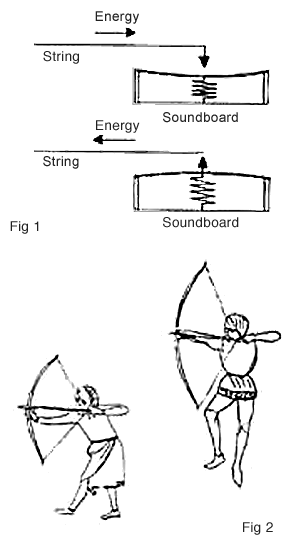[ the craft of the guitar maker ]
By TREVOR SEMPLE4. The Soundboard (Part2)
IT IS often in the nature of things that improvements carry with them other inherent disadvantages. For example, maybe a new plane flies faster, but it has worse fuel economy.Volume, tone and sustain of musical instruments seem to work in this way as well. Sometimes improvements in one direction are immediately reflected by losses in another. For a while I saw guitar-making as a sort of circular juggling act, but this is really not the case. There is a way out of the imprisoning circle. It is no great secret. All you need is a more efficient design. You can have your cake and eat it!
Unfortunately, the soundboard of an instrument is a rather complicated affair, and the precise way of getting your hands on the cake is not altogether obvious. In this, the final article on soundboards, we look at how the thing actually works.
Without a soundboard, you would not hear very much after plucking the string. You would, in fact, have an electric guitar and no amplifier. Strings are not the right shape to move large volumes of air. They are small, thin, unassuming sorts of things. To get air moving, you want a large flattish surface to beat backwards and forwards. There may well be a few sitting in your front room, called loudspeakers.
On an acoustic instrument, this is the role of the soundboard. The strings move the bridge, and the bridge moves the soundboard, and the soundboard moves the air, and the air moves the eardrum ....
All remarkably straightforward. But if it all happened instantaneously, then the sound would disappear in one big blast, and be gone so fast you would hardly hear anything at all. At any given moment, a lot of the string energy does not vibrate the air at all. Air is not easy stuff to move about if you are a soundboard. Air pushes back and tries to resist the soundboard movement. Because the air is hard to move, the soundboard is hard to move, and the bridge is hard to move. Just like ripples in the water hitting the hard edge of a swimming pool, the string vibrations hit the 'hard' bridge. Then they reflect back down the string again, and the cycle starts all over again. This we perceive as sustain. Acoustically 'hard' soundboards have considerably improved sustain, while acoustically 'soft' ones, like most flamenco guitars, have shorter more percussive notes.
In order to get the best note from a single plucked string, it is necessary to build soundboards that are extremely light. The guitar maker faces far greater constraints than, for example, the violin maker. Guitars are deliberately built closer to their structural limits, and the skill lies in walking the tightrope. Plucked strings are not designed to give great sustain, so the aim is for resilience. The soundboard is like a spring and can store energy, so as well as the string giving energy to the soundboard, the soundboard then kicks back and puts new vibrating energy into the string (Fig 1).
Improvements in volume come from converting string energy more efficiently into sound. If you can reduce energy losses in the system, you have a louder guitar. There are various ways this can be done, including making changes to the soundboard inertia or damping characteristics.
Many changes to guitar design have followed a similar path to the keyboards. The early Italian harpsichord shows a number of parallels with the flamenco guitar (strangely enough it also had casework commonly made of cypress wood). The guitars of Torres' time could be likened to the fortepiano. Modern instruments, in their quest for greater power and projection, have moved further down the evolutionary path, sometimes with larger bodies, or longer strings at higher tension. This works on the principle that more energy is locked up in the system in the form of greater string mass or higher tensions that stress the soundboard harder. Once the system is set into motion, this energy can be released as sound.
The easiest way to visualise this is probably to think of a longbow (Fig 2). A larger bow can be pulled back more and so fires the arrow further. There are of course disadvantages well known to readers of the Odyssey! Very powerful bows are extremely difficult to draw when you do not possess the physique of Rambo or Odysseus. The same is true of guitars. Harder string tensions may well give some desirable results, but the penalties are severe. After a point, the left hand has to work much harder to hold down chords, while the strings are so unyielding to the right hand that it becomes jarring on the fingers and many subtleties of tone are lost. Piano hammers may be totally indifferent to such changes, but our hands, unfortunately, are not. Finding paths through the labyrinth of possibilities provides the interest and joy (and sometimes frustration) of making instruments. Once we have all the variables luthiers can tailor a sound to have the qualities we require. By separating the various forces acting on the instrument it is sometimes possible to make selective changes to some qualities of the sound without adversely affecting others. Sometimes, this is the way to the cake!
©1990 Trevor Semple
"Classical Guitar Magazine", November 1990


